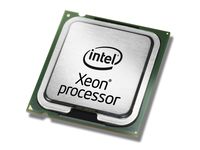Six-Core Intel Xeon 7400 Shipping September 15
When the going gets tough in the enterprise server sector you need big processing power. Larger and more complex database systems, scientific computation and web servers demand more and more power every other day.
More power usually ends up meaning more physical hardware taking up more space. This is something that Intel is working hard towards minimizing – increase the processing power and reducing the footprint.
The last of the Penryn class enterprise processors is on the way. Boasting a huge 16MB L3 cache. This is Intel’s first step beyond four cores. The new Xeon 7400 (Dunnington) will have six cores and be the first using the new monolithic design - multiple cores on a single die. The Xeon 7400 will be socket compatible with Xeon 7300 boards which will allow for simple upgrades with little downtime.
The Xeon 7300 series were high-wattage as well, some pushing 130 watts. The new 7400 series is targeting a much lower wattage, however no solid data has been available – upon its actual release we should start to see what kind of numbers are out there in real world application.
Previous 7300 series Xeon processors weighed in at four cores and a hefty 8 MB cache and a very large price tag that ranges between $2,200 to $2,600. As no solid pricing information has been released regarding the new 7400 series, one could expect the 7400 come in little more than current 7300 pricing while 7300 series take a price slash. It would be logical to expect pricing around $2,600 to $2,800.
Enterprise processor markets have never had consistent pricing like the consumer processor market, so finding the right deal can be a lot of work for smaller businesses that wish to save a few bucks. Larger entities tend to worry more about what it can do for them as opposed to the sticker price.
Since this will be the last of this server era from Intel, it may not see much daylight as large entities are already planning their road map towards Nehalem, especially due to the architecture’s scalability. On a side note - if rumors continue to hold true, we should be seeing the Core i7 (Nehalem) line rolling out by the end of this year.
Get Tom's Hardware's best news and in-depth reviews, straight to your inbox.
-
alvine Replyt would be logical to expect pricing around $2,600 to $2,800.
=O Holy shi for that money you can build high end system -
mtyermom Alvine=O Holy shi for that money you can build high end systemReply
These are for enterprise server application (major datacenters) and NOT for gaming PCs...
So these prices, especially compared to the price and processing power of the previous generation (7300), are not that surprising. -
jimmysmitty ^Yep and mainly because the silicon used for these CPUs is of the highest quality available. They basically are the most reliable CPUs out there.Reply
Avery server CPU is this way and cost much more, even AMD and IBM server CPUs. -
martel80 Alvine=O Holy shi for that money you can build high end system When one minute (or hour or even day) of the system operation is worth its price (like it is in enterprise), then the price itself is one of the least concerns.Reply -
JonathanDeane martel80When one minute (or hour or even day) of the system operation is worth its price (like it is in enterprise), then the price itself is one of the least concerns.Reply
I agree, I was working for a company and our tools went down for something like 3 days (software patch issue I believe, but I was never told the actual reason) and for each of these 3 days they told me they where losing something like 2-3 million dollars. Mind you this was not that huge of a company. -
crockdaddy I happen to think the Crysis jokes are wholly appropriate lol. To think its almost a year since release and most machines still can't run Crysis with all the bells and whistles turned on. Which belies the point as to why no one bought the game in the first place. Vote me down as you will but its true.Reply
-
Reynod crockdaddy that is moreso because the graphics power has not been available to push Crysis along.Reply
My Crysis CD is sitting here waiting too ...
Runs like crap on a Q6600@3Ghz with a 9600GT.
Plus I am trying to get rid of all my Nvidia cards ... before they all fail anyway. No point in overclocking an NVidia card when we know all of the 7 series and up are failty.
Better to have 2 X 4850's (or 4879's) or an X2 version ... so the story goes.
